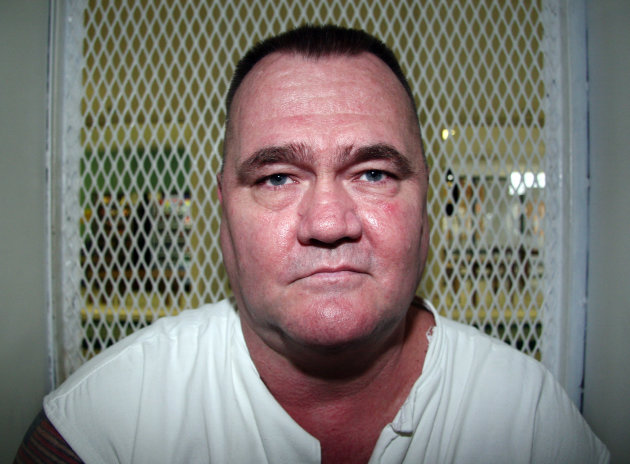By Fenit Nirappil

In most courtrooms, spontaneous applause could get you thrown out.
But in this San Francisco court, it's expected — and strongly encouraged for the >defendants
.
Bowls
of hard candy rest in front of the judge's bench, as a reward for the
men and women making their weekly court appearances and attending group therapy
. Almost daily, the judge awards one standout a $5 grocery store gift card — while the gallery claps and cheers.
These
scenes have played out thousands of times at the Community Justice
Center, a novel, 4-year-old court system in the city's rough-edged
Tenderloin district. It's one of about 40 community courts
around the United States
that tackle mostly low-level crimes in troubled neighborhoods using
judges — not juries — to send defendants to drug treatment, shelter and social services, instead of handing down fines and time in overcrowded jails.
"We
go to the root of the problems rather than just throwing them in jail,"
said the Community Justice Center's lone judge, Lillian Sing.
But
it's not all carrots and no sticks. When obviously drunk or drugged
defendants stagger into the courtroom, the judge swiftly sends them to
jail for a few days to sober up.
"This is called tough love," Sing
recently told one teary-eyed defendant as a deputy handcuffed him. "I
don't want to see you die on the streets."
U.S. Department of
Justice officials say community courts improve public safety by focusing
on the crimes that are less high-profile but affect day-to-day life.
They say the courts, along with similar rehabilitative courts, represent
a shift away from judges just herding people through the system.
"Judges
started figuring out they could help solve problems, so there was a
switch to looking at outcomes instead of process," said Kim Ball, a
senior policy adviser.
And unlike the thousands of specialized
drug courts across America, community courts are designed to provide
quicker, cheaper justice while improving life in specific neighborhoods
or police precincts. Defendants perform community service in the
neighborhoods where they broke the law. Taggers must paint over
graffiti. And shoplifters are required to help distribute clothes to the
poor.
The movement toward community courts began almost two
decades ago in New York City, which established one in Midtown Manhattan
to crack down on prostitution, graffiti and other street crimes.
The
system has reached its "awkward teen years," after passing its
experimental stage and steadily gaining acceptance, said Greg Berman,
director of the New York-based Center for Court Innovation, a nonprofit
that advises community courts using U.S. Department of Justice funding.
"We've
seen these ideas which were derided and dismissed by many in the '90s
as totally loopy and beyond the pale become, if not totally
mainstreamed, more and more embraced by court systems and criminal
justice systems across the country," Berman said.
States with community courts include Minnesota, Indiana, New Jersey, Connecticut, Virginia, Georgia
, Texas, Tennessee, Utah, Colorado, Oregon and Washington.
Defendants
often are brought into court and therapy several times a week, even for
infractions such as sleeping on streets, aggressive panhandling and
public urination.
"These are low-level offenses for which, in the
past, there may not have been any kind of response from the criminal
justice system," said Williams College Professor James Nolan, who has
studied rehabilitative courts across the world.
Famously tolerant
San Francisco was late to embrace community courts. But the city, along
with a handful of others, took the model to a new level by also using
the court as an alternative for prosecuting more serious but nonviolent
crimes, including vehicle theft and felony drug offenses.
The
Community Justice Center opened in a nondescript building amid an
uproar from some progressives, who feared it would disproportionately
target the poor and homeless.
But criticism subsided as the court
helped relieve the caseload clogging traditional courtrooms by handling
4,500 defendants since it opened. And the city has found it metes out
swift justice, with defendants on average coming to court a week after
they are cited, compared with 45 days for a regular court.
Police
Captain John Garrity, whose district is served by the Community Justice
Center, says his officers can focus more on serious crime because the
court gets the lower level offenders into social services, where they
leave less likely to re-offend than they are from short jail stints.
Most
defendants see an on-site social worker who creates a treatment plan
and connects them to nonprofits and group therapy. Each is expected to
comply with the plan or risk getting kicked back to the traditional
courthouse, where jail time is more likely.
"Incarceration is not
always the answer," said San Francisco's district attorney and former
police chief, George Gascon. "It often leads to a cycle of re-offending,
especially at the low-level offenses."
While it's been difficult
for researchers to determine cost savings, new studies suggest community
courts are helping stem crime.
An evaluation of Washington, D.C.'s community court
by the Westat research firm found this summer that defendants who
successfully completed diversion programs from 2007 to 2009 were half as
likely to re-offend as similar defendants in a traditional court.
Russell Canan, presiding judge of the capitol's criminal courts, attributes this to defendants getting more attention.
"The
judges are engaging with defendants to see what kind of work they are
doing, what their school situation is, what type of social services they
need," Canan said. And then they coach and inspire them to make good
choices.
Researchers studying a New York court have released similar preliminary findings. San Francisco's court is undergoing a study.
But
critics of community courts say recidivism statistics are misleading
because many the courts' defendants are low-level offenders, rather than
career criminals.
"There's a
point at which it's plain overkill," said Steven Zeidman, a law
professor at the City University of New York. "We bring in all kinds of
things that are so minor: riding on the sidewalk, three kids arrested
for smoking one joint together, kids shoplifting a piece of candy."



 Mitt
Romney made headlines last week when a video surfaced of him declaring
that 47% of the country’s citizens do not take personal responsibility
for their lives and are dependent on the government. He also mocked the
idea that health care is an entitlement. Well, an entitlement is
something that someone has a legal right to, something they are owed,
based on legal principles and cultural values. In our political
discourse, however, the word “entitlement” is often used to refer to
something that someone does not deserve. Personally, I think everyone
should have a right to health care because our society should value
human dignity enough to guarantee access to medical treatment regardless
of an individual’s ability to pay. I think health care should be an
entitlement, in the sense that everyone should have a right to it based
on our civil laws and religious values.
Mitt
Romney made headlines last week when a video surfaced of him declaring
that 47% of the country’s citizens do not take personal responsibility
for their lives and are dependent on the government. He also mocked the
idea that health care is an entitlement. Well, an entitlement is
something that someone has a legal right to, something they are owed,
based on legal principles and cultural values. In our political
discourse, however, the word “entitlement” is often used to refer to
something that someone does not deserve. Personally, I think everyone
should have a right to health care because our society should value
human dignity enough to guarantee access to medical treatment regardless
of an individual’s ability to pay. I think health care should be an
entitlement, in the sense that everyone should have a right to it based
on our civil laws and religious values.






 At one corner, I saw a cop grabbing the arm of a woman in front of me
and pulling her into the street. It was the same gesture you might use
to escort an old lady, and, when the next officer did this to me, that
is what I thought it was. But then, halfway across the street, he cuffed
my hands behind my back.
At one corner, I saw a cop grabbing the arm of a woman in front of me
and pulling her into the street. It was the same gesture you might use
to escort an old lady, and, when the next officer did this to me, that
is what I thought it was. But then, halfway across the street, he cuffed
my hands behind my back.


















